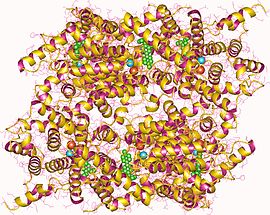| 3',5'-cyclic nucleotide phosphodiesterase | |||||||||
|---|---|---|---|---|---|---|---|---|---|
 Phosphodiesterase 4D hexamer, Human | |||||||||
| Identifiers | |||||||||
| Symbol | PDEase_I | ||||||||
| Pfam | PF00233 | ||||||||
| InterPro | IPR002073 | ||||||||
| PROSITE | PDOC00116 | ||||||||
| SCOP2 | 1f0j / SCOPe / SUPFAM | ||||||||
| CDD | cd00077 | ||||||||
| |||||||||
| 3′,5′-cyclic-nucleotide phosphodiesterase | |||||||||
|---|---|---|---|---|---|---|---|---|---|
| Identifiers | |||||||||
| EC no. | 3.1.4.17 | ||||||||
| CAS no. | 9040-59-9 | ||||||||
| Databases | |||||||||
| IntEnz | IntEnz view | ||||||||
| BRENDA | BRENDA entry | ||||||||
| ExPASy | NiceZyme view | ||||||||
| KEGG | KEGG entry | ||||||||
| MetaCyc | metabolic pathway | ||||||||
| PRIAM | profile | ||||||||
| PDB structures | RCSB PDB PDBe PDBsum | ||||||||
| Gene Ontology | AmiGO / QuickGO | ||||||||
| |||||||||
3′,5′-cyclic-nucleotide phosphodiesterases (EC 3.1.4.17) are a family of phosphodiesterases. Generally, these enzymes hydrolyze a nucleoside 3′,5′-cyclic phosphate to a nucleoside 5′-phosphate:
- nucleoside 3′,5′-cyclic phosphate + H2O = nucleoside 5′-phosphate
They thus control the cellular levels of the cyclic second messengers and the rates of their degradation.[1] Some examples of nucleoside 3′,5′-cyclic phosphate include:
- 3′,5′-cyclic AMP
- 3′,5′-cyclic dAMP
- 3′,5′-cyclic IMP
- 3′,5′-cyclic GMP
- 3′,5′-cyclic CMP
There are 11 distinct phosphodiesterase families (PDE1–PDE11) with a variety in isoforms and splicing having unique three-dimensional structure, kinetic properties, modes of regulation, intracellular localization, cellular expression, and inhibitor sensitivities.[1]
Nomenclature[edit]
The systematic name for this enzyme is 3′,5′-cyclic-nucleotide 5'-nucleotidohydrolase. Other names in use include:
- PDE,
- cyclic 3′,5′-mononucleotide phosphodiesterase,
- cyclic 3',5'-nucleotide phosphodiesterase,
- cyclic 3′,5′-phosphodiesterase,
- 3′,5′-nucleotide phosphodiesterase,
- 3':5'-cyclic nucleotide 5′-nucleotidohydrolase,
- 3′,5′-cyclonucleotide phosphodiesterase,
- 3′,5′-cyclic nucleoside monophosphate phosphodiesterase,
- 3′:5′-monophosphate phosphodiesterase (cyclic CMP),
- cytidine 3′:5′-monophosphate phosphodiesterase (cyclic CMP),
- cyclic 3′,5-nucleotide monophosphate phosphodiesterase,
- nucleoside 3′,5′-cyclic phosphate diesterase, and
- nucleoside-3′,5-monophosphate phosphodiesterase.
Function[edit]
Phototransduction[edit]
Retinal 3′,5′-cGMP phosphodiesterase (PDE) is located in photoreceptor outer segments and is an important enzyme in phototransduction.[2]
3′,5′-cyclic-nucleotide phosphodiesterases in rod cells are oligomeric, made up of two heavy catalytic subunits, α (90 kDa) and β (85 kDa,) and two lighter inhibitory γ subunits (11 kDa each).[3][4]
PDE in rod cells are activated by transducin. Transducin is a G protein which upon GDP/GTP exchange in the transducin α subunit catalyzed by photolyzed rhodopsin. The transducin α subunit (Tα) is released from the β and γ complex and diffuses into the cytoplasmic solution to interact and activate PDE.
Activation by Tα[edit]
There are two proposed mechanisms for the activation of PDE. The first proposes that the two inhibitory subunits are differentially bound, sequentially removable and exchangeable between the native complex PDEαβγ2 and PDEαβ. GTP-bound-Tα removes the inhibitory γ subunits one at a time from the αβ catalytic subunits.[3] The second and more likely mechanism states that the GTP-Tα complex binds to the γ subunits but rather than dissociating from the catalytic subunits, it stays with the PDEαβ complex.[5][6] Binding of the GTP-Tα complex to the PDE γ subunits likely causes a conformational shift in the PDE, allowing better access to the site of cGMP hydrolysis on PDEαβ.[5]
Structure[edit]
The binding site for PDE α and β subunits are likely to be in the central region of the PDE γ subunits.[4] The C-terminal of the PDE γ subunit is likely to be involved in inhibition of PDE α and β subunits, the binding site for Tα and GTPase accelerating activity for the GTP-bound Tα.[6]
In cones, PDE is a homodimer of α chains, associated with several smaller subunits. Both rod and cone PDEs catalyze the hydrolysis of cAMP or cGMP to their 5′ monophosphate form. Both enzymes also bind cGMP with high affinity. The cGMP-binding sites are located in the N-terminal half of the protein sequence, while the catalytic core resides in the C-terminal portion.
Examples[edit]
Human genes encoding proteins containing this domain include:
- PDE1A, PDE1B, PDE1B2, PDE1C, PDE2A, PDE3A, PDE3B, PDE4A, PDE4B, PDE4B5, PDE4C, PDE4D,
- PDE5A, PDE6A, PDE6B, PDE6C, PDE7A, PDE7B, PDE8A, PDE8B, PDE9A,
- PDE10A, PDE10A2, PDE11A,
References[edit]
- ^ a b Bender AT, Beavo JA (September 2006). "Cyclic nucleotide phosphodiesterases: molecular regulation to clinical use". Pharmacological Reviews. 58 (3): 488–520. doi:10.1124/pr.58.3.5. PMID 16968949. S2CID 7397281.
- ^ Arkinstall S, Watson SP (1994). "Opsins". The G-protein linked receptor factsbook. Boston: Academic Press. pp. 214–222. ISBN 978-0-12-738440-5.
- ^ a b Deterre P, Bigay J, Forquet F, Robert M, Chabre M (April 1988). "cGMP phosphodiesterase of retinal rods is regulated by two inhibitory subunits". Proceedings of the National Academy of Sciences of the United States of America. 85 (8): 2424–8. doi:10.1073/pnas.85.8.2424. PMC 280009. PMID 2833739.
- ^ a b Kovacik, Lubomir; Stahlberg, Henning; Engel, Andreas; Palczewski, Krzysztof; Gulati, Sahil (2019-02-01). "Cryo-EM structure of phosphodiesterase 6 reveals insights into the allosteric regulation of type I phosphodiesterases". Science Advances. 5 (2): eaav4322. doi:10.1126/sciadv.aav4322. ISSN 2375-2548. PMC 6392808. PMID 30820458.
- ^ a b Kroll S, Phillips WJ, Cerione RA (March 1989). "The regulation of the cyclic GMP phosphodiesterase by the GDP-bound form of the alpha subunit of transducin". The Journal of Biological Chemistry. 264 (8): 4490–7. doi:10.1016/S0021-9258(18)83770-X. PMID 2538446.
- ^ a b Liu Y, Arshavsky VY, Ruoho AE (January 1999). "Interaction sites of the C-terminal region of the cGMP phosphodiesterase inhibitory subunit with the GDP-bound transducin alpha-subunit". The Biochemical Journal. 337 (2): 281–8. doi:10.1042/0264-6021:3370281. PMC 1219963. PMID 9882626.